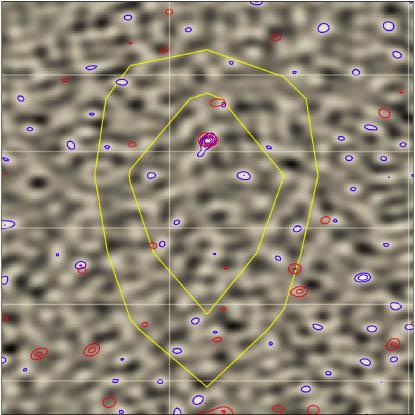
An image of the sky with a rare, massive, "dusty star-forming galaxy" dating from about one billion years after the big bang. The Submillimeter Array results at 850 microns are shown in greyscale and with blue contours, and at 1.1 millimeters with red contours; the SCUBA-2 submillimeter contours (having much lower spatial resolution) are shown in yellow.
Galaxies that are very luminous in the infrared are generally active in making new stars whose ultraviolet radiation heats the dust. The energy, re-radiated by the dust at infrared wavelengths, is characterized by having a broad spectral shape with a distinct emission peak. As the universe expands, and as the observed spectra of galaxies shift to the red, light at the wavelength of this peak moves into the submillimeter band leaving the levels of observed infrared flux deficient. Star-forming galaxies in the very distant universe are thus fainter in the infrared than in the submillimeter.
Thousands of galaxies have been discovered dating from epochs only a few billion years after the big bang. Most of them are small, low-mass galaxies that are faint and relatively difficult to study. Although more luminous, massive star-forming galaxies should also be present, these large objects are difficult to assemble at early cosmic times and there are not as many of them. One type of such luminous early galaxy is called a dusty-star-forming galaxy. They contain so much obscuring dust that they are invisible at optical wavelengths, and (based on their luminosities) have star-formation rates exceeding a thousand solar-masses per year; for comparison, the Milky Way produces about one star per year.
Dusty star-forming galaxies in the earliest epochs, less than two billion years after the big bang, are particularly rare and hard to find, but they are extremely valuable in helping understand how the first galaxies develop. CfA astronomer Glen Petitpas was a member of a team of astronomers who used the SCUBA-2 camera (Submillimeter Common User Bolometer Array-2) and the far-infrared Herschel SPIRE instrument to discover and characterize a dusty star-forming galaxy. They serendipitously detected the unusual galaxy in a SCUBA-2 survey. When they realized that the object was not detected by Herschel - or by any other optical or infrared survey, suggesting that its infrared peak had moved very far to the red - they concluded that it likely was from an extremely early epoch.
The team then used the Submillimeter Array, with a spatial resolution about ten times finer than SCUBA-2, to confirm the detection and study the source. Since a firm distance measurement requires detecting a spectral line and measuring its redshift, the scientists also tried using other submillimeter facilities suitable for line searches, but without success. Nevertheless, from the flux limits at various wavelengths they were able to make a strong case that this object is a massive, dusty star-forming galaxy, among the first generation of massive galaxies in the universe and dating from between roughly seven hundred million and one billion years after the big bang.
"A SCUBA-2 Selected Herschel-Spire Dropout and the Nature of This Population," J. Greenslade, E. Aguilar, D. L. Clements, H. Dannerbauer, T. Cheng, G. Petitpas, C. Yang , H. Messias, I. Oteo, D. Farrah, M. J. Michałowski, I. Perez Fournon, I. Aretxaga, M. S. Yun, S. Eales, L. Dunne, A. Cooray, P. Andreani, D. H. Hughes, M. Velázquez, D. Sánchez-Argüelles, N Ponthieu, MNRAS 490, 5317.